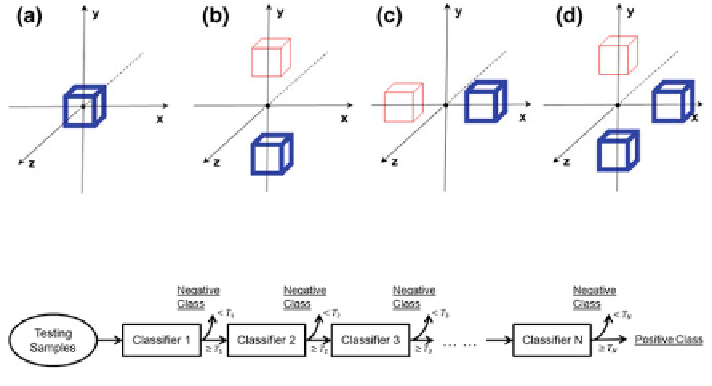Information Technology Reference
In-Depth Information
By scaling the mother functions and convoluting them with the original image, a
set of spatial-frequency spaces are constructed as Eq. (
5
).
F
l
ð
x
;
s
Þ
¼
H
l
ð
sx
Þ
I
ð
x
Þ
ð
5
Þ
where s and l denote the scaling factor and index of mother functions, respectively.
Finally, for any voxel x
0
2<
3
, its feature vector
is obtained by sampling
these spatial-frequency spaces in the neighborhood of x
0
(Eq.
6
). It provides cross-
scale appearance descriptions of voxel x
0
.
Fð
x
0
Þ
[
l¼1
...
L
f
F
l
ð
x
i
;
s
j
Þj
x
i
2
N
ð
x
0
Þ;
s
min
\
s
j
\
s
max
g
Fð
x
0
Þ
¼
ð
6
Þ
Compared to standard Haar wavelet, the mother functions we employed are not
orthogonal. However, they provide more comprehensive image features to char-
acterize different anatomy primitives. For example, as shown in Fig.
3
, mother
function (a) potentially works as a smoothing
filter, which is able to extract regional
features. Mother functions (b) and (c) can generate horizontal or vertical
”
responses, which are robust to local noises. More complicated mother function like
(d) is able to detect
“
edgeness
patterns, which might be useful to distinguish some
anatomy primitives. In addition, our features can be quickly calculated through
integral image [
21
]. It paves the way to an ef
“
L-shape
”
cient anatomy detection system.
All elementary features are then fed into a cascade classi
cation framework [
22
]
as shown in Fig.
4
. The cascade framework is designed to address the highly
unbalanced positive and negative samples. In fact, since only voxels around ver-
tebrae centers or intervertebral discs are positives, the ratio of positives to negatives
is often less than 1:10
5
. In the training stage, all positives but a small proportion of
Fig. 3 Some examples of haar-based mother functions

